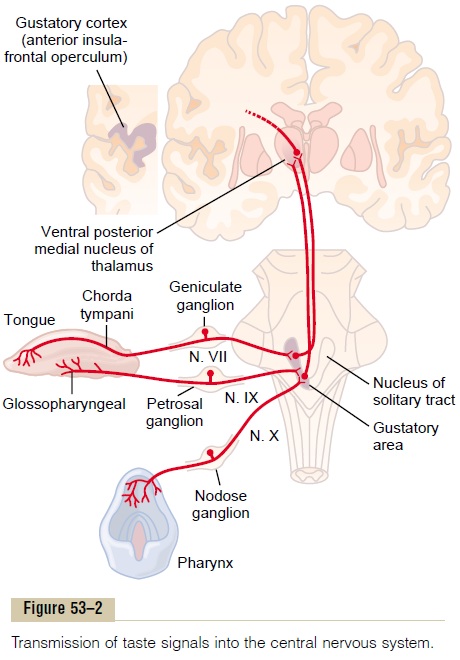Chapter: Medical Physiology: The Chemical Senses-Taste and Smell
Transmission of Taste Signals into the Central Nervous System
Transmission of Taste Signals into the Central Nervous System
Figure 53–2 shows the neuronal pathways for trans-mission of taste signals from the tongue and pharyn-geal region into the central nervous system. Taste impulses from the anterior two thirds of the tongue pass first into the lingual nerve, then through the chorda tympani into the facial nerve, and finally intothe tractus solitarius in the brain stem. Taste sensations from the circumvallate papillae on the back of the

tongue and from other posterior regions of the mouth and throat are transmitted through the glossopharyngeal nerve also into the tractus solitarius, but at a slightly more posterior level. Finally, a few taste signals are transmitted into the tractus solitarius from the base of the tongue and other parts of the pharyngeal region by way of the vagus nerve.
All taste fibers synapse in the posterior brain stem in the nuclei of the tractus solitarius. These nuclei send second-order neurons to a small area of the ventral posterior medial nucleus of the thalamus, located slightly medial to the thalamic terminations of the facial regions of the dorsal column–medial lemniscal system. From the thalamus, third-order neurons are transmitted to the lower tip of the postcentral gyrus in the parietal cerebral cortex, where it curls deep into the sylvian fissure, and into the adjacent opercular insular area. This lies slightly lateral, ventral, and rostral to the area for tongue tactile signals in cerebral somatic area I. From this description of the taste pathways, it is evident that they closely parallel the somatosensory pathways from the tongue.
Taste Reflexes Integrated in the Brain Stem. From the tractus solitarius, many taste signals are transmitted within the brain stem itself directly into the superior and inferior salivatory nuclei, and these areas transmit signals to the submandibular, sublingual, and parotid glands to help control the secretion of saliva during the ingestion and digestion of food.
Adaptation of Taste. Everyone is familiar with the fact that taste sensations adapt rapidly, often almost completely within a minute or so of continuous stimulation.Yet, from electrophysiologic studies of taste nerve fibers, it is clear that adaptation of the taste buds themselves usually accounts for no more than about half of this. Therefore, the final extreme degree of adaptation that occurs in the sensation of taste almost certainly occurs in the central nervous system itself, although the mechanism and site of this are not known. At any rate, it is a mechanism different from that of most other sensory systems, which adapt almost entirely at the receptors.
Related Topics